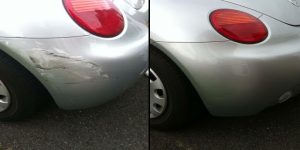Whether it’s a small scratch, a dent from a parking lot mishap, or more extensive damage, car body repairs are essential for keeping your vehicle looking its best and maintaining its value. In this guide, we’ll cover the basics of car body repairs, the types of damage you might encounter, and the benefits of regular maintenance. If you’re considering bringing your car to a body shop, here’s what you can expect.
Common Types of Car Body Damage
Scratches and Scuffs: These are often caused by minor bumps, debris, or even brushing against bushes. While they may seem minor, untreated scratches can lead to rust and deeper paint issues. That can bring such a nasty look to your car, right?
Dents and Dings: From hailstorms to door impacts, dents and dings are among the most common types of car body damage. 5 out of 10 car body repairs are dent and ding related. Depending on their size, they can sometimes be repaired using paintless dent removal (PDR) techniques.
Bumper Damage: Bumpers are designed to absorb impact, but they’re often the first part of a car to sustain damage in a collision. Repairing or replacing a bumper can improve both the aesthetics and safety of your vehicle.
Frame Damage: In severe accidents, the car’s frame might get bent or damaged, affecting safety and alignment. Frame repairs require specialised equipment and expertise to ensure the car’s structural integrity.
Benefits of Regular Car Body Maintenance
Just like the human body, your car needs regular maintenance. There are many benefits attached when you pay attention to it. Below are some of the benefits:
Protects Against Rust and Corrosion: Small scratches or chips in the paint can expose the metal underneath, leading to rust over time. Regular maintenance can prevent this.
Maintains Your Car’s Value: A well-maintained exterior can help retain your car’s resale value. Cars with visible damage may lose their appeal to potential buyers.
Improves Safety: Certain types of body damage, like frame issues or cracked bumpers, can affect your car’s safety. Addressing these issues promptly helps ensure your car is roadworthy.
Boosts Curb Appeal: Keeping your car’s body in good shape not only makes it look great but also reflects well on you as a car owner.
What to Expect at a Car Body Shop
Assessment and Estimate: When you bring your car to a body shop, an expert technician will assess the damage and provide you with a repair estimate. This is often based on the extent of damage and the parts needed.
Repair Process: Depending on the damage, your car might need paint touch-ups, part replacements, or even structural repairs. Professional body shops use specialised tools and techniques to ensure quality repairs.
Paint Matching: If your car requires paintwork, the shop will use colour-matching technology to blend the new paint seamlessly with the original color, making the repair unnoticeable.
Quality Control and Final Inspection: Once repairs are completed, a reputable body shop will conduct a final inspection to ensure everything looks perfect and meets their standards. With this, you can be sure your car has been well taken care of.
Conclusion
Investing in car body repairs isn’t just about looks; it’s about protecting your car’s value, safety, and longevity. By understanding the different types of repairs and knowing what to expect when visiting a body shop, you’ll be better prepared to take care of your vehicle’s appearance. Your car deserves the best touch, and you are the one who can decide to give it to it.
You can also check how to spot and prevent damage.
Need expert car body repairs in Luton? Contact Modus Car Body Repairs to learn more about how we can restore your car to its best condition.

Leave a Comment